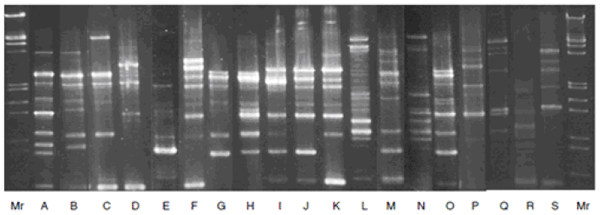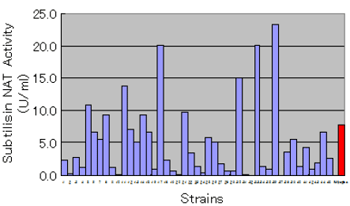Germplasm evaluation of Bacillus subtilis strains in Thua nao, a traditional fermented soybean food in northern Thailand
Description
Thua nao is a traditional fermented soybean food in northern Thailand. Its fermentation is mainly carried out using Bacillus subtilis (natto) in a process that is very similar to that of Japanese Natto. However, since Thua nao is usually produced under traditional home manufacturing conditions, its fermentation occurs with more diverse selection of Bacillus subtilis strains as compared with that of the Japanese Natto, which is made in modern factories with a few selected strains. Because of the diversity of Bacillus subtilis strains used in Thua nao fermentation, it could be expected to contain more superior Bacillus subtilis strains than those found in Natto.
In this study, 45 strains of Bacillus subtilis (natto) were isolated from nine Thua nao samples from eight markets in Chiang Rai and Payao prefectures in northern Thailand, and their characteristics were compared with “Miyagino”, one of the typical Natto-producing strains. Their molecular diversity was analyzed via randomly amplified polymorphic DNA-PCR (RAPD) fingerprinting. Based on the results, the strains were divided into 19 types, including one with the same RAPD pattern as that of “Miyagino” (Figure 1). The production of amylase, protease, subtilisin NAT (Natto kinase) and gamma-polyglutamic acid (PGA) by the strains was measured. Protease productivity of the strains was almost the same as that of “Miyagino”, but their productivity for amylase, subtilisin NAT and PAG was higher than that of “Miyagino” . Figure 2 shows the subtilisin NAT activity of the strains isolated from Thua Nao..
These results clearly demonstrated the value of Thua nao as a potential resource of food-processing enzymes and health-promoting compounds. Traditional fermented foods such as Thua nao contain valuable bioresources, but they are rapidly being lost in developing countries. Hence, we have to warn these countries about it before they miss the opportunity to preserve these valuable resources.
Figure, table
-
Figure 1. Lanes A to S indicate the different RAPD patterns of the strains isolated from Thua nao.
(Natto-producing strain “Miyagino” gave a pattern similar to the one shown in Lane A.) -
Fig 2. Subtilisin NAT activity of the strains isolated from Thua Nao
(The red bar indicates the Natto-producing strain “Miyagino”.) -
-
- Affiliation
-
Japan International Research Center for Agricultural Sciences Post-harvest Science and Technology Division
- Classification
-
Technical A
- Term of research
-
FY2006
- Responsible researcher
-
FUSHIMI Tsutomu ( Post-harvest Science and Technology Division )
LADDA Wattanasiritham ( Institute of Food Research and Product Development, Kasetsart University, Thailand )
INATSU Yasuhiro ( National Food Research Institute )
NAKAMURA Nobutaka ( National Food Research Institute )
KAWAMOTO Shinichi ( National Food Research Institute )
- ほか
- Publication, etc.
-
Inatsu, Y. Nakamura, N. Yoshida, Y. Fushimi, T. Wattanasiritham, L. Kawamoto, S. (2006):Characterization of Bacillus subtilis strains in Thua nao, a traditional fermented soybean food in northern Thailand. the Letters in Applied Microbiology, 43, 237-242
FUSHIMI, T. et al. (2005) [Abstract of the 52th Annual meeting of the Japanese Society for Food Science and Technology], p.121
INATSU, Y. et al. (2005) Isolation and characterization of Bacillus subtilis (natto) strains from a fermented soybean food produced in Thailand, Abstracts of the Annual Meeting of the Japan Society of Cookery Science, 132
- Japanese PDF


